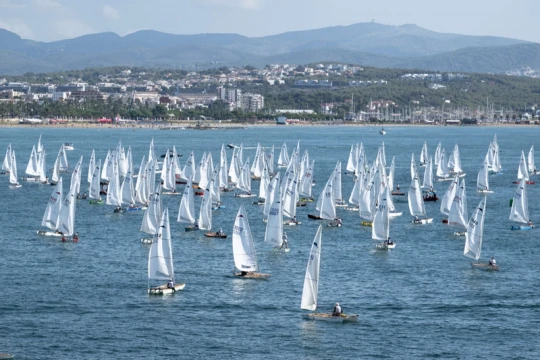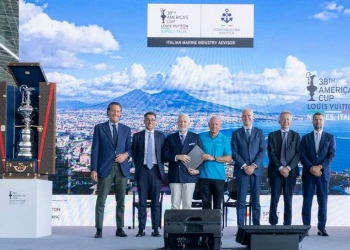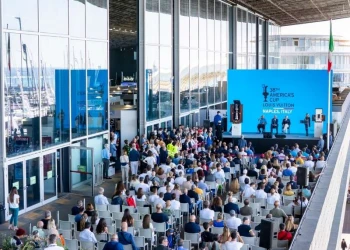
Ricardo Pinto / America's Cup
Record fleet expected as more than 300 Patí de Vela’s confirmed for America’s Cup
The bond between the Louis Vuitton 37th America’s Cup and the fleet of Patí de Vela beach-launched catamarans continues with a celebratory regatta over the weekend of 19-20 October 2024, that is expected to beat all records and see more than 300 entries.
The Patí Català class is huge along the Mediterranean coast. The popular 18-foot-long, catamaran with a 5.24-foot beam features no rudder, centreboard, or boom, and is controlled by minute adjustments on the dovetail mainsail and exquisite use of body weight to steer.
A press conference announcing this record-breaking regatta was attended by the Mayor of Barcelona, Jaume Collboni and Grant Dalton CEO of America's Cup Event, along with: Gerard Esteva, President de la Unió de Federacions Esportives de Catalunya; David Escudé, Councilor of Sports of Barcelona City Council; Miquel Àngel Alonso, President of ADIPAV; Josep Maria Isern, president of Federació Catalana de Vela; and Ignasi Armengol, director general of Fundació Barcelona Capital Nàutica, as well as other institutional and sports representatives.
During the press conference the Mayor spoke about the importance of the class–most often referred to as the 'Patí Català' – and its connection to Barcelona, saying: "The Patí Català is a very genuine way of sailing in the city and our drive/intention/vocation is that it will continue for many more years. We must remember that we are a city of the sea."
The first association between the Louis Vuitton 37th America’s Cup and the class was at Vilanova i la Geltrú in September 2023 for the first Preliminary Regatta where some 210 of these fabulous dinghies, filled the horizon and provided the most magical of backdrops.
The regatta in Barcelona is set to eclipse this, and Gerard Esteva, himself a Patí de Vela sailor, former president of the International Association of Patí de Vela Owners (ADIPAV) and President of the Union of Sports Federations of Catalonia (UFEC), is excited at what is about to be achieved:
“I’m thrilled to share a historic achievement with you: we currently have 320 registered participants in the America’s Cup of Patí. This extraordinary milestone isn’t even the peak, as we’ve decided to keep registrations open for now. We firmly believe we can reach 330 participants, which would be an absolute Guinness World Record.
"It’s an incredible moment for all of us, the participants’ enthusiasm is palpable, and this is fantastic news for the Louis Vuitton 37th America’s Cup, for Patí, for sailing, and for Barcelona. The bond we are forging between popular sailing and the America’s Cup is a real turning point. The response from the Patí community has been overwhelmingly positive, and this fills us with joy.”
The Official Race Village of the Louis Vuitton 37th America’s Cup was recently the stage for an extraordinary honouring of some 90 Catalan Olympians. As Gerard Esteva commented: “It was an amazing gathering with over 700 attendees. We honoured 90 Catalan Olympians, many of whom are medallists, and we were able to publicly acknowledge their dedication. We also awarded the ‘Female Commitment Prize’ at the America’s Cup, which was accepted by Aurora Catà, Vice President of America’s Cup Event, the organising body of the Louis Vuitton 37th America’s Cup. It was a memorable ceremony.”
The president of Club Patí Vela Barcelona, Rafel Figuerola, who also spoke. highlighted the exceptional nature of the regatta: "In the preliminary regatta in Vilanova we gathered 200 patins and now we are going to make history. We have the chance to show the world the strength of our boat."
Grant Dalton, CEO of America’s Cup Event, has been a major supporter of the link with the class, even donating a boat to the local club adorned in the Emirates Team New Zealand livery.
Talking about the event, Dalton commented: “The enthusiasm around this class is infectious and it’s not often that we see professional sailors stopped in the tracks and trying to figure out how these great sailors control the craft. Getting 320 boats here to Barcelona is a huge milestone for the class and we’re delighted to continue our support as an event and look forward to the spectacle on the water. Congratulations and thanks to Gerard and his team for having the vision to do this.”
ABOUT THE PATÍ DE VELA
On just about any day of the week, at noon, these pure craft can be seen launched off the Barceloneta and Badalona beachfronts whilst weekend racing is both popular and highly contested. The origins of the Patí de Vela can be traced back to the 1870s and the beach off Badalona where fishermen would stand on two hulls and paddle out to check nets but by the early part of the 20th century, the paddles that were similar to modern-day canoeists paddles, were replaced by oars and the craft were adapted for recreation and at times, racing, with the crew sitting down and rowing.
In 1942, the Mongé brothers from Catalonia first started experimenting with wooden masts and sails, placing the foot of the mast far forward and introducing the dovetail mainsail. The addition of a steel rack across the stern, a feature that is still there today, allowed the batten-less mainsail to be sheeted wide but could, crucially, be flattened for upwind work.
As the technique developed so did the control lines and on today’s craft, the Patí de Vela ‘skates’ feature an array of control systems that can alter the forestay tension on each tack (the boats have two forestays, one mounted on each hull) to control the bend of the mast and aid direction.
About 40 ‘skates’ are built every year and although the original boats were built entirely of wood (hull and mast), now hybrid skates have gained ground, with fiberglass floats, a wooden deck and an aluminium mast.
The biggest factor for controlling these boats is body weight. Moving forward to luff-up and aft to bear-away with the single sailor moving across the five beams that support the hulls. The sailing style has naturally adapted with the ages as in early videos, sailors can be seen standing upright and precariously stepping forwards and back.
Today, the sailors of these fascinating craft are more often found lying across the five hull planks and making small body movements and ‘crawls’ to shift distribution. In lighter airs there is still a beautiful balancing technique of standing up whilst flying the windward hull that proves to be very fast upwind with minute adjustments on the mainsail to keep the boat at optimum pace.
All the control systems lead back to the ‘piano’ an area at the midpoint of the craft between the hulls on the crossbeams that delivers the crucial free-flying cunningham and stay adjustments whilst the mainsheet feeds forward and is trimmed from just aft of the mast so the helm can keep looking forward. It’s a boat that rewards technique with many sailors spending a lifetime perfecting their balance and control, whilst the racing is fast and desperately close all the way through the fleet.
A curiosity born from innovation in Catalonia, the Patí de Vela class also has fleets in France, Holland and Belgium but their uniqueness in the world of sailing makes them remarkable boats to see on the water and inspires much debate as to how these highly skilled sailors, sailing in the purest form of the sport, control their vessels with such dexterity.





